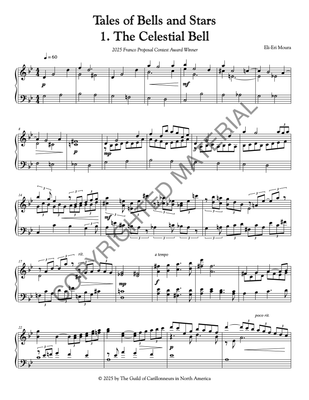
[PDF] Tales of Bells and Stars
Winner, 2025 Franco Proposal Contest
Movements
- The Celestial Bell
- The Bell and the Star Child
- The Bell Tower of the Stars
Program notes
Tales of Bells and Stars includes three short pieces that portray fables in whose narratives a strong relationship between bells and stars emerges. In the first, The Celestial Bell (a short rhapsody), the story draws from Greek mythology, where the huntsman Orion journeys to Lemnos. There, as our tale goes... Hephaestus, the god of blacksmiths and craftsmanship, gifts Orion the Celestial Bell, which is said to summon the stars whenever it rings. With the bell's power, Orion calls upon the stars to aid him in his quests. The stars guide him across treacherous seas and through dark forests, ensuring his safe passage. Upon completing his journey, Orion is honored by being placed among the stars as a constellation, forever reminding mortals of the bell's celestial power.
The tale created for the second piece, The Bell and the Star Child (a little rondeau), takes as its starting point a moving story entitled "For Always" by Will Fish involving a six-year-old Russian orphan named Misha, who invents his own versions of the Christmas story. In our new narrative, Misha imagines a fantastical world that is loosely based on a combination of the fairy tales "The Bell" by Hans Christian Andersen and "The Star-Child" by Oscar Wilde. Accordingly, the story follows a young orphan named Misha who finds a magical bell in the forest. When he rings it, a star descends from the sky, transforming into a beautiful child. The Star Child befriends Misha and helps him through difficult times, using starlight to guide him and ward off dangers. Misha and the Star Child embark on adventures, spreading light and hope to others. The bond between the bell and the star symbolizes the connection between heaven and earth, showing how small acts of kindness can light up the darkest nights.
The third piece, The Bell Tower of the Stars (a mini dance suite), depicts a tale inspired by Giotto's Bell Tower in Florence. A legend associated with this tower tells of its designer, Giotto di Bondone, who was challenged to create a structure that would reach the stars. Giotto's design was so magnificent that angels were believed to come down to admire it, and the tower was said to sing, producing harmonious sounds when the wind passed through its arches. Another reference is the Torrazzo of Cremona, the tallest bell tower in Italy, which houses the largest astronomical clock in the world. Our story unfolds in an Italian village where a bell tower is built so tall that it seems to touch the stars. Every night, the bell ringer, an old man named Giuseppe, rings the bell, believing it brings blessings from the stars to the village. One clear night, the bell rope snaps, and Giuseppe climbs the tower to fix it. As he reaches the top, he sees the stars up close and is inspired by their beauty. Upon his return, he tells the villagers about the stars' message of hope and unity. The villagers start a tradition of stargazing and bellringing, fostering a sense of community and wonder.
—Eli-Eri Moura
![[PDF] Tales of Bells and Stars [PDF] Tales of Bells and Stars](https://d2j6dbq0eux0bg.cloudfront.net/images/9481258/4958222781.png)
